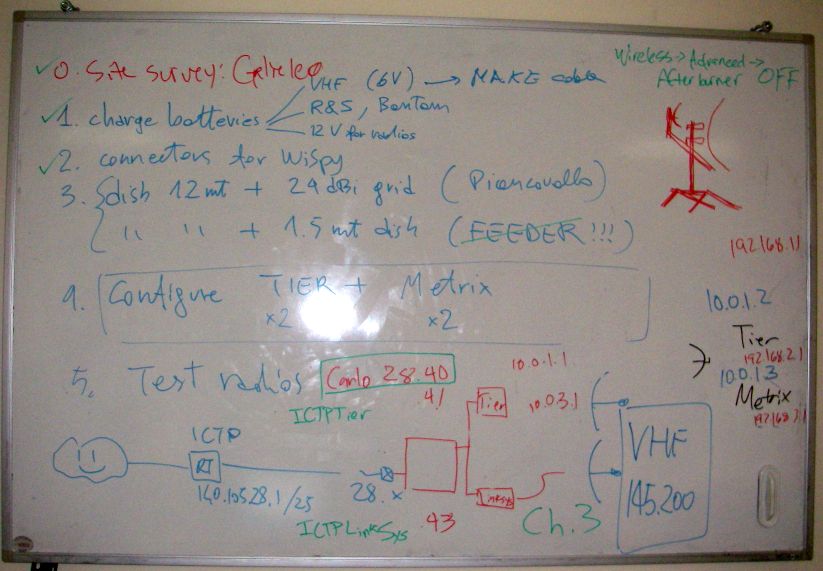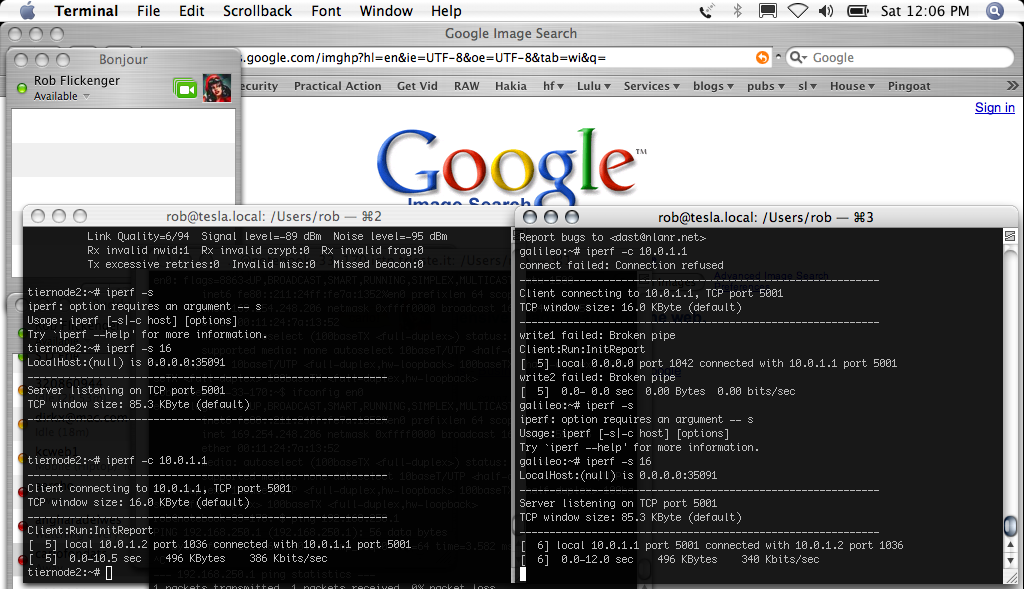Long Distance Link
From School2007
Contents |
[edit] The experiment
Make a wireless connection from the Galileo to Piancavallo, about 101 Km away. We successfully established a connection at around noon on 17 February 2007.
Flickr photo group for the event. If you have photos, please email Rob to be invited to the group.
[edit] Preparation
[edit] The location
The Google Earth file for the Trieste-Piancavallo trip is available Media:Trieste-Piancavallo.kmz.zip.
[edit] Success
Screen shots from the iChat AV video conference are also available.
[edit] Technical details
- Galileo side used a TIER box in AP mode.
- Piancavallo side used a TIER box for test #1 and a Metrix box for test #2.
[edit] Preparation
The IP addresses used:
- Internet: 140.105.28.41
- Galileo side radio: 10.0.1.1
- Remote side radio: 10.0.1.2
- Remote side wire (eth0): 192.168.1.1
We configured NAT on both sides of the link, as this provided the simplest routing solution.
In the lab the night before, we tested throughput between the two TIER boxes. With the radios sync'd at 36 Mbps (802.11g), we saw approximately 17 Mbps throughput in both directions.
The link distance was initially set to 120 Km on all devices. After a site survey using the WiSpy and the Rohde & Schwarz confirmed the ambient noise, we used channel 3 (2.422 GHz) for the link.
Unless otherwise noted, all bandwidth performance tests were made using iperf
[edit] Link up
The 100 Km link was achieved at 12:03 pm on Saturday, February 17
Piancavallo side radio at that time:
ath0 IEEE 802.11g ESSID:"ICTPTier"
Mode:Managed Frequency:2.422 GHz Access Point: 00:15:6D:53:90:42
Bit Rate:36 Mb/s Tx-Power:16 dBm Sensitivity=0/3
Retry:off RTS thr:off Fragment thr:off
Encryption key:off
Power Management:off
Link Quality=6/94 Signal level=-89 dBm Noise level=-95 dBm
Rx invalid nwid:1 Rx invalid crypt:0 Rx invalid frag:0
Tx excessive retries:0 Invalid misc:0 Missed beacon:0
iperf results on the first established link: 386 Kbps down / 340 Kbps up
We then changed the link distance to 102 Km. The iperf results then showed 19.6 Kbps down / 15 Kbps up. Ongoing throughput results continued to be very low regardless of the distance setting. We eventually realized that the devices could only be reset by cycling power on both ends.
The throughput testing vs. distance settings procedure was not terribly scientific, as we didn't realize for quite a while that the devices needed to be reset after making a change. By this point, we were quite cold and wanted to move on to other tests. We then set the link distance to 140 Km on all devices, as this seemed to provide the best throughput.
[edit] Disabling ACKs
At Rabin from Berkeley's suggestion, ACKs were disabled on the AP side with this command:
iwpriv ath0 setwmmparams 6 0 0 1
This resulted in no clear difference in bit rate (the testing showed about 120 Kbps average in both directions, both before and after the change.)
[edit] Forced bitrate
Again on advice from Rabin, we forced the radio rate to 1 Mbps using this command:
sysctl -w /dev/mad0/fixed11rate=1000
This resulted in very poor performance (1.1 Kbps down / 1.0 Kbps up). Both devices were then power cycled and the link was restored.
[edit] Metrix
Once the link was stable again, we replaced the TIER box on the Piancavallo side with a Metrix Mark II using the same SR2 radio card.
- Bitrate with radio @ 36 Mbps: ~85 Kbps up / down
- Bitrate with radio forced to 11Mbps: 592 Kbps down / 616 Kbps up
[edit] Other observations
The link quality varied throughout the day. The available signal fluctuated from -64 dBm to -87 dBm (a difference of 23dB!) The average of all signal samples taken was -77 dBm.
We noted that the signal level definitely varied with the wind speed. We expect that the link would be far more stable if the large dish on the Piancavallo side were fixed in place more securely.
Also, since the Metrix box (running Pyramid v1.0b5) had no trouble associating with the TIER at the Galileo, and in fact performed better using 802.11b, we expect that no changes were made to the MAC on the TIER boxes. It is possible that these changes are missing from the version of the OS we used, and will be made in an upcoming TIER release.
In addition to iperf testing, we transferred a few files using SCP, and saw bit rates comparable to the iperf readings. We were able to use video conferencing with a limited bitrate of 100 Kbps. We also used voice over IP, email, and web connections with no problem. At one point, we were using five laptops simultaneously over the link as we all wanted to tell our loved ones where we were. ;-)


